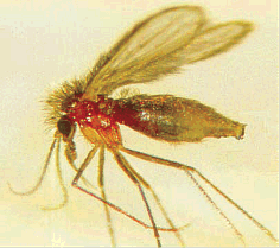
Researchers at LSTM have found that due to widespread insecticide resistance and poor quality assurance of spraying activities, that DDT-based indoor residual spraying programmes may not be the key to the elimination of visceral leishmaniasis in India.
Visceral leishmaniasis (VL), also known as kala-azar, is a major parasitic disease. It is particularly prevalent in India with 80% of the world’s cases of VL recorded in three Indian states, making the key to global elimination of the disease its control within in India. It is transmitted to humans by the bite of infected female sand flies. As with malaria, indoor residual spraying (IRS) of houses and animal shelters can be used to control and, ultimately, eliminate VL. A range of insecticides could be used for IRS, however a decision was made to use dichlorodiphenyltrichloroethane or DDT for IRS in India despite the controversy surrounding it. Ecological issues are due to the bioaccumulation properties and high toxicity in relation to exposure to humans and wildlife which is associated with persistent organic pollutants (POP), the group of insecticides to which DDT belongs.
The programme of IRS has encountered significant challenges because of growing insecticide resistance, lack of good quality assurance and limited surveillance of infection insect populations. Researchers from LSTM’s Department of Vector Biology, working alongside colleagues at the Rajendra Memorial Research Institute of Medical Sciences at the Indian Council of Medical Research, gathered this missing evidence in order to improve the Indian VL programme by examining eight endemic districts in Bihar State, India and the results are published this week in PNAS.
Their findings reveal that nearly 85% of households were under-sprayed, with only 7.4% of household walls containing the proper amount of DDT and an almost equal percentage containing a higher than recommended amount. Significant differences in the abundance of sand flies in both treated and untreated villages were observed only at one month after indoor residual spraying. Resistance to DDT was prevalent, though the insects were susceptible to the insecticide deltamethrin. Given the poor quality of the DDT-based IRS, the ready availability of DDT alternatives such as pyrethroids and the susceptibility profile of Indian sand flies, the authors note that the continued use of DDT in this IRS program is questionable.
LSTM’s Director, Professor Janet Hemingway, is the corresponding author of the study. She said: “Our study presented entomological abundance and insecticide resistance data as well as data arising from the quality assurance of IRS in order to establish an evidence base to improve the Indian VL elimination programme. The issues highlighted in our work must be addressed if India is to achieve the goal of regional elimination of VL as a public health problem, otherwise their efforts will fail.”
Michael Coleman, Geraldine M. Foster, Rinki Deb, Rudra Pratap Singh, Hanafy M. Ismail, Pushkar Shivam, Ayan Kumar Ghosh, Sophie Dunkley, Vijay Kumar, Marlize Coleman, Janet Hemingway, Mark J. I. Paine, and Pradeep Das
DDT-based indoor residual spraying suboptimal for visceral leishmaniasis elimination in India
PNAS 2015 : 1507782112v1-201507782.